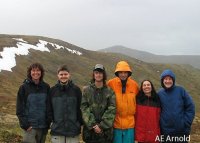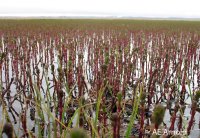Introduction
Dimensions of Biodiversity: An Interdisciplinary Study of Hyperdiverse Endophytic Fungi and their Function in Boreal Forests
Introduction
For additional information, contact Betsy Arnold (Arnold@ag.arizona.edu)
Through interactions spanning mutualism to parasitism, symbioses sculpt biological processes at scales ranging from molecules to ecosystems, thus influencing both the rate of branching and breadth of the tree of life. Although long recognized for their important roles as decomposers, Fungi reach their greatest genetic, taxonomic, and functional diversity through symbiosis: from mycorrhizal mutualists to virulent pathogens, fungal symbionts of photosynthetic organisms are cryptic but powerful determinants of terrestrial biomass, nutrient cycling, and ecosystem productivity from the poles to the equator.
Despite their importance, <100,000 species of Fungi have been described thus far. Most are known because of their fruit bodies (e.g., saprotrophs), the damage they cause (pathogens or parasites), or their emergent properties (lichens). However, the vast majority of yet-undiscovered fungal diversity occurs among symbiotic Ascomycota that rarely manifest their presence with visual cues on their hosts. These include the hyperdiverse fungal endophytes, a species-rich, phylogenetically diverse, and ecologically important guild of plant-symbiotic fungi estimated to comprise as many as 1 million species – of which < 1% have been discovered and described so far.
Endophytic fungi. The overarching goal of this project is to examine the diversity of endophytic fungi -- one of the most ubiquitous but least-studied groups of symbionts on earth. Endophytes occur within healthy above-ground tissues of all plants (and in lichens as endolichenic fungi) in biomes ranging from tropical forests to Arctic tundra. Defined functionally as fungi living within plants or lichens without causing detectable symptoms of disease, diverse, horizontally transmitted endophytes have been found in every plant and lichen species examined thus far, and increasingly are recognized as an accessible but under-exploited trove of ecological, genetic, and functional diversity.
Endophytes produce metabolites of use in agriculture, medicine, and industry, and provide an array of previously understudied benefits to their hosts, including defense against pests and pathogens, and – of special relevance in the era of climate change – tolerance to heat and drought. Although abundant and diverse in all terrestrial biomes, endophytes peak in phylogenetic diversity in boreal forests.
Boreal forests. As the world’s largest biome, boreal forests span >11% of Earth’s land area and comprise ca. 40% of global forest cover. They provide an array of critical ecosystem functions, serving as refuges for biodiversity, influencing global CO2 and hydrologic cycles, and both driving and responding to global climate. By 2100, climate change is expected to impose greater warming in boreal and arctic regions than in other terrestrial biomes, profoundly affecting biodiversity and species composition and yielding massive downstream effects on the net carbon balance and climate feedbacks driven by earth’s high-latitude ecosystems. As agents of physiological modification, functional diversification, and genetic evolution, symbionts such as endophytes will play key roles in mitigating and driving responses of boreal forests to climate change.
Objectives. In the first study of its scale for any group of symbiotic microbes, we will discover and evaluate the taxonomic, genetic, and functional diversity of fungal endophytes. We have chosen to focus on boreal forests, a threatened but important biome that provides the ideal context for addressing the dimensions of endophyte diversity. Through a multidisciplinary, international, and highly integrative approach we will achieve five key aims:
• Aim 1. Unveil the scale of endophyte biodiversity. Using an unprecedentedly broad and deep culture-based and culture-free survey of phylogenetically diverse, boreal plants and lichens at local, regional, and intercontinental scales, we will determine the scope and distribution of endophyte diversity with regard to hosts, geography, and ecologically relevant environmental factors.
• Aim 2. Establish transformative taxonomic practices and select optimal model systems for functional and genetic studies. We will use novel and collaborative phylogenetic- and population-level approaches to efficiently, accurately, and rapidly circumscribe taxonomic diversity, cataloguing and describing new species of endophytes, inferring the evolution of their ecological modes, and guiding our selection of strains for functional and genetic analyses and development of novel model systems.
• Aim 3. Empirically assess functional diversity of endophytes. Using phylogenetically structured sampling we will evaluate, for the first time, the diversity, breadth, and evolution of eco-logically relevant functional traits of newly discovered endophytes, quantifying their substrate utilization, enzyme activity, host-symbiotic interactions, and secondary metabolite production.
• Aim 4. Identify mechanisms underlying genetic diversity of endophytes. Using cytological, microbiological, and genomic approaches, we will comprehensively assess the roles of endohyphal viral and bacterial symbionts, nuclear genomic fluidity (variation in nuclear number, mobile genetic features), and genome evolution in shaping the genetic diversity and functional biology of endophytes.
• Aim 5. Data management and release. With emphasis on quality control, fair release, and public access, we will share our data, protocols, results, and biodiversity informatics tools through a unified web portal, which will integrate our research with outreach, workshops, international collaborations, and mentorship of high-school, undergraduate, graduate, and postdoctoral researchers.








